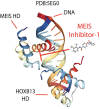Oncogenic and tumor suppressor function of MEIS and associated factors
- PMID: 33402862
- PMCID: PMC7759197
- DOI: 10.3906/biy-2006-25
Oncogenic and tumor suppressor function of MEIS and associated factors
Abstract
MEIS proteins are historically associated with tumorigenesis, metastasis, and invasion in cancer. MEIS and associated PBX-HOX proteins may act as tumor suppressors or oncogenes in different cellular settings. Their expressions tend to be misregulated in various cancers. Bioinformatic analyses have suggested their upregulation in leukemia/lymphoma, thymoma, pancreas, glioma, and glioblastoma, and downregulation in cervical, uterine, rectum, and colon cancers. However, every cancer type includes, at least, a subtype with high MEIS expression. In addition, studies have highlighted that MEIS proteins and associated factors may function as diagnostic or therapeutic biomarkers for various diseases. Herein, MEIS proteins and associated factors in tumorigenesis are discussed with recent discoveries in addition to how they could be modulated by noncoding RNAs or newly developed small-molecule MEIS inhibitors.
Keywords: MEIS; MEIS inhibitors; cancer; small molecules.
Copyright © 2020 The Author(s).
Conflict of interest statement
CONFLICT OF INTEREST: FK is the founder of Meinox (www.meinoxtech.com, funded by TÜBİTAK TEYDEB, grant # 2180742). All of the other authors declare that they have no conflicts of interest concerning this work.
Figures



Similar articles
-
Hox cofactors in vertebrate development.Dev Biol. 2006 Mar 15;291(2):193-206. doi: 10.1016/j.ydbio.2005.10.032. Epub 2006 Mar 3. Dev Biol. 2006. PMID: 16515781 Review.
-
Variable Meis-dependence among paralog group-1 Hox proteins.Biochem Biophys Res Commun. 2005 Jun 17;331(4):1384-91. doi: 10.1016/j.bbrc.2005.04.063. Biochem Biophys Res Commun. 2005. PMID: 15883028
-
MEIS C termini harbor transcriptional activation domains that respond to cell signaling.J Biol Chem. 2005 Mar 18;280(11):10119-27. doi: 10.1074/jbc.M413963200. Epub 2005 Jan 15. J Biol Chem. 2005. PMID: 15654074
-
An inhibitory switch derepressed by pbx, hox, and Meis/Prep1 partners regulates DNA-binding by pbx1 and E2a-pbx1 and is dispensable for myeloid immortalization by E2a-pbx1.Oncogene. 1999 Dec 23;18(56):8033-43. doi: 10.1038/sj.onc.1203377. Oncogene. 1999. PMID: 10637514
-
MEIS transcription factors in development and disease.Development. 2019 Aug 15;146(16):dev174706. doi: 10.1242/dev.174706. Development. 2019. PMID: 31416930 Review.
Cited by
-
The chromatin landscape of high-grade serous ovarian cancer metastasis identifies regulatory drivers in post-chemotherapy residual tumour cells.Commun Biol. 2024 Sep 28;7(1):1211. doi: 10.1038/s42003-024-06909-9. Commun Biol. 2024. PMID: 39341888 Free PMC article.
-
Profiling the heterogeneity of colorectal cancer consensus molecular subtypes using spatial transcriptomics.NPJ Precis Oncol. 2024 Jan 10;8(1):10. doi: 10.1038/s41698-023-00488-4. NPJ Precis Oncol. 2024. PMID: 38200223 Free PMC article.
-
MEIS1 in Hematopoiesis and Cancer. How MEIS1-PBX Interaction Can Be Used in Therapy.J Dev Biol. 2021 Oct 13;9(4):44. doi: 10.3390/jdb9040044. J Dev Biol. 2021. PMID: 34698191 Free PMC article. Review.
-
The Roles of H3K9me3 Writers, Readers, and Erasers in Cancer Immunotherapy.Int J Mol Sci. 2024 Oct 25;25(21):11466. doi: 10.3390/ijms252111466. Int J Mol Sci. 2024. PMID: 39519018 Free PMC article. Review.
-
Unraveling the interplay: exploring signaling pathways in pancreatic cancer in the context of pancreatic embryogenesis.Front Cell Dev Biol. 2024 Aug 22;12:1461278. doi: 10.3389/fcell.2024.1461278. eCollection 2024. Front Cell Dev Biol. 2024. PMID: 39239563 Free PMC article. Review.
References
-
- Aamar E Frank D Xenopus Meis3 protein forms a hindbrain-inducing center by activating FGF/MAP kinase and PCP pathways. Development. 2004;131:153–163. - PubMed
-
- Abate-Shen C Deregulated homeobox gene expression in cancer: cause or consequence. Nature Reviews Cancer. 2002;2:777–785. - PubMed
-
- Abbaszadegan MR Moghbeli M Role of MAML1 and MEIS1 in esophageal squamous cell carcinoma depth of invasion. Pathology & Oncology Research. 2018;24:245–250. - PubMed
-
- Agoston Z Heine P Brill MS Grebbin BM Hau AC Meis2 is a Pax6 co-factor in neurogenesis and dopaminergic periglomerular fate specification in the adult olfactory bulb. Development. 2014;141:28–38. - PubMed
-
- Aksoz M Turan RD Albayrak E Kocabas F Emerging roles of meis1 in cardiac regeneration, stem cells and cancer. Current Cancer Drug Targets. 2018;19:181–190. - PubMed
LinkOut - more resources
Full Text Sources
